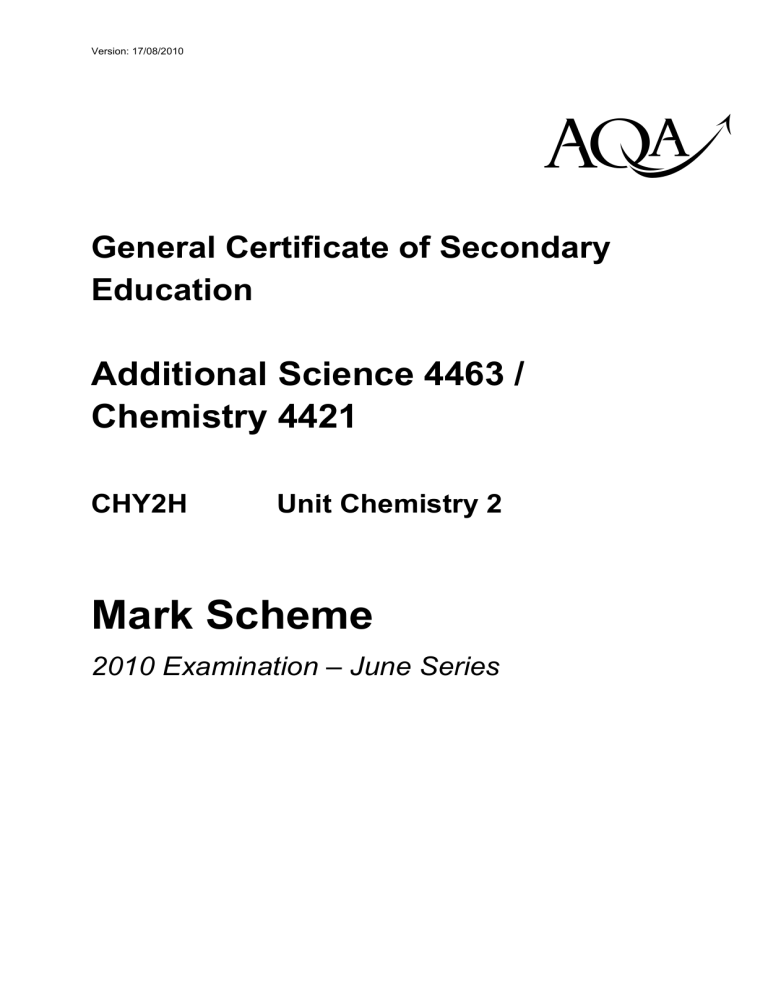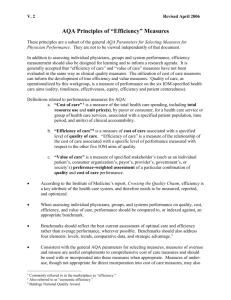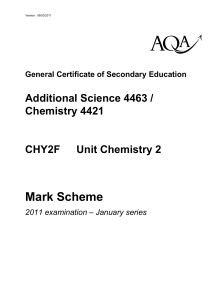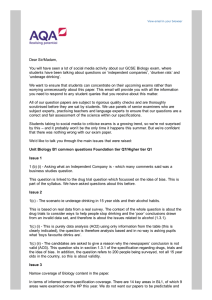
Version: 17/08/2010
klm
General Certificate of Secondary
Education
Additional Science 4463 /
Chemistry 4421
CHY2H
Unit Chemistry 2
Mark Scheme
2010 Examination – June Series
Mark schemes are prepared by the Principal Examiner and considered, together with the
relevant questions, by a panel of subject teachers. This mark scheme includes any
amendments made at the standardisation meeting attended by all examiners and is the scheme
which was used by them in this examination. The standardisation meeting ensures that the
mark scheme covers the candidates’ responses to questions and that every examiner
understands and applies it in the same correct way. As preparation for the standardisation
meeting each examiner analyses a number of candidates’ scripts: alternative answers not
already covered by the mark scheme are discussed at the meeting and legislated for. If, after
this meeting, examiners encounter unusual answers which have not been discussed at the
meeting they are required to refer these to the Principal Examiner.
It must be stressed that a mark scheme is a working document, in many cases further
developed and expanded on the basis of candidates’ reactions to a particular paper.
Assumptions about future mark schemes on the basis of one year’s document should be
avoided; whilst the guiding principles of assessment remain constant, details will change,
depending on the content of a particular examination paper.
Further copies of this Mark Scheme are available to download from the AQA Website: www.aqa.org.uk
Copyright © 2010 AQA and its licensors. All rights reserved.
COPYRIGHT
AQA retains the copyright on all its publications. However, registered centres for AQA are permitted to copy material
from this booklet for their own internal use, with the following important exception: AQA cannot give permission to
centres to photocopy any material that is acknowledged to a third party even for internal use within the centre.
Set and published by the Assessment and Qualifications Alliance.
The Assessment and Qualifications Alliance (AQA) is a company limited by guarantee registered in England and Wales (company number 3644723) and a registered charity (registered charity number 1073334).
Registered address: AQA, Devas Street, Manchester M15 6EX
Additional Science / Chemistry CHY2H – AQA Mark Scheme 2010 June series
Marking Guidance for Examiners
GCSE Science Papers
1.
General
The mark scheme for each question shows:
•
the marks available for each part of the question
•
the total marks available for the question
•
the typical answer or answers which are expected
•
extra information to help the Examiner make his or her judgement and help to
delineate what is acceptable or not worthy of credit or, in discursive answers, to give
an overview of the area in which a mark or marks may be awarded.
The extra information is aligned to the appropriate answer in the left-hand part of the
mark scheme and should only be applied to that item in the mark scheme.
At the beginning of a part of a question a reminder may be given, for example:
where consequential marking needs to be considered in a calculation;
or the answer may be on the diagram or at a different place on the script.
In general the right hand side of the mark scheme is there to provide those extra details
which confuse the main part of the mark scheme yet may be helpful in ensuring that
marking is straightforward and consistent.
2.
3.
Emboldening
2.1
In a list of acceptable answers where more than one mark is available ‘any two
from’ is used, with the number of marks emboldened. Each of the following lines
is a potential mark.
2.2
A bold and is used to indicate that both parts of the answer are required to award
the mark.
2.3
Alternative answers acceptable for a mark are indicated by the use of or.
(Different terms in the mark scheme are shown by a / ; eg allow smooth / free
movement.)
Marking points
3.1
Marking of lists
This applies to questions requiring a set number of responses, but for which
candidates have provided extra responses. The general principle to be followed
in such a situation is that ‘right + wrong = wrong’.
Each error/contradiction negates each correct response. So, if the number of
error/contradictions equals or exceeds the number of marks available for the
question, no marks can be awarded.
However, responses considered to be neutral (indicated as * in example 1) are
not penalised.
3
Additional Science / Chemistry CHY2H – AQA Mark Scheme 2010 June series
Example 1: What is the pH of an acidic solution? (1 mark)
Candidate
Response
Marks
awarded
1
4,8
0
2
green, 5
0
3
red*, 5
1
4
red*, 8
0
Example 2: Name two planets in the solar system. (2 marks)
3.2
Candidate
Response
Marks awarded
1
Pluto, Mars, Moon
1
2
Pluto, Sun, Mars,
Moon
0
Use of chemical symbols / formulae
If a candidate writes a chemical symbol / formula instead of a required chemical
name, full credit can be given if the symbol / formula is correct and if, in the
context of the question, such action is appropriate.
3.3
Marking procedure for calculations
Full marks can be given for a correct numerical answer, as shown in the column
‘answers’, without any working shown.
However if the answer is incorrect, mark(s) can be gained by correct
substitution / working and this is shown in the ‘extra information’ column;
3.4
Interpretation of ‘it’
Answers using the word ‘it’ should be given credit only if it is clear that the ‘it’
refers to the correct subject.
3.5
Errors carried forward
Any error in the answers to a structured question should be penalised once only.
Papers should be constructed in such a way that the number of times errors can
be carried forward are kept to a minimum. Allowances for errors carried forward
are most likely to be restricted to calculation questions and should be shown by
the abbreviation e.c.f. in the marking scheme.
3.6
Phonetic spelling
The phonetic spelling of correct scientific terminology should be credited unless
there is a possible confusion with another technical term.
3.7
Brackets
(…..) are used to indicate information which is not essential for the mark to be
awarded but is included to help the examiner identify the sense of the answer
required.
4
Additional Science / Chemistry CHY2H – AQA Mark Scheme 2010 June series
CHY 2H
Question 1
question
1(a)(i)
answers
extra information
(nitrogen) + hydrogen → ammonia accept H2 and NH3
mark
1
ignore incorrect symbols
ignore balancing
1(a)(ii)
1
any one from:
•
catalyst
•
to speed up the reaction
ignore causes reaction
ignore heat / reference to
particles
•
1(a)(iii)
lower activation energy
any two from:
•
cooled
•
ammonia condenses / turns
into liquid
•
nitrogen and hydrogen do not
condense / turn into liquid
it = ammonia
2
ignore references to boiling point
or
nitrogen and hydrogen stay as
gases
if no marks awarded accept pass
through / separated in condenser
or unreacted nitrogen and
hydrogen / gases recycled for 1
mark
Question 1 continues on the next page
5
Additional Science / Chemistry CHY2H – AQA Mark Scheme 2010 June series
CHY 2H
Question 1 continued
question
1(b)
answers
80
extra information
correct answer with or without
working gains 2 marks
mark
2
ignore units
if answer incorrect, evidence of
correct working gains 1 mark
eg
14 + (4 x 1) + 14 + (3 x 16) (= 70)
or
2N + 4H +30
1(c)
fertiliser is C
evidence of correct working
1
examples of minimum correct
working:
1
39/101
or
14/101
or
38.61/100
or
13.86/100
Total
8
6
Additional Science / Chemistry CHY2H – AQA Mark Scheme 2010 June series
CHY 2H
Question 2
question
answers
extra information
mark
2(a)(i)
(different) properties
allow ideas of different property /
behaviour / element
1
2(a)(ii)
any one from:
they = Crawford + Cruikshank
1
•
they had high status
or
they were lecturers / doctors /
professors / famous scientists
•
other scientists repeated
experiments
•
they had proof
allow experiment could be
repeated
allow other scientists showed they
had different properties
or
lots of / strong / conclusive /
enough / clear evidence
2(a)(iii)
ignore evidence unqualified
other scientists obtained similar
results / proved it
1
or
experiments were repeated
Question 2 continues on the next page
7
Additional Science / Chemistry CHY2H – AQA Mark Scheme 2010 June series
CHY 2H
Question 2 continued
question
2(b)(i)
answers
extra information
any one from:
mark
1
•
mass of solid / strontium
(chloride) / barium (chloride)
allow amount / volume
•
volume of water
allow amount / mass
•
type of container
allow initial / starting temperature
(of water)
ignore room temperature / time /
concentration
ignore reference to hydrochloric
acid
2(b)(ii)
2 and takes in heat / energy
1
or
2 and temperature goes down
(owtte)
2(b)(iii)
temperature increased for one
experiment and decreased for the
other (owtte)
1
or
one was exothermic and one was
endothermic (owtte)
2(c)
accept experiment 1 was
exothermic
any one from
•
positive / + (charge)
•
opposite (charges) attract
1
do not accept incorrect further
qualification eg electrons / atoms /
electrodes
Total
7
8
Additional Science / Chemistry CHY2H – AQA Mark Scheme 2010 June series
CHY 2H
Question 3
question
3(a)
3(b)(i)
answers
extra information
mark
2,4 (drawn as crosses) on shells
accept dots / e / - etc.
1
hard
allow rigid / high melting point
1
do not allow references to
bonding
ignore strong
ignore unreactive
ignore structure
3(b)(ii)
any three from
max 2 if ionic / metallic / molecule
/ intermolecular bonds or
incorrect number of bonds
•
giant structure / lattice /
macromolecular
allow many bonds
•
covalent (bonds)
•
(covalent) bonds are strong
•
(each) carbon / atom forms
four bonds
3
accept needs lots of energy to
break bonds (owtte)
or
(each) carbon / atom bonded
to four other atoms
Question 3 continues on the next page
9
Additional Science / Chemistry CHY2H – AQA Mark Scheme 2010 June series
CHY 2H
Question 3 continued
question
3(c)
answers
any three from:
extra information
max 2 if ionic / ions / metallic /
molecule
mark
3
‘it’ needs to be qualified
graphite
•
has delocalised / free
electrons
do not accept the electrons move
unless qualified (around structure
etc)
or
electrons that can move
through / around the structure
•
each carbon is joined to three
other carbon atoms
allow graphite has three bonds
or
one electron from each atom
is free / delocalised
diamond
•
has no free / delocalised
electrons
or
do not accept the electrons do
not move
no electrons that move
around the structure
•
all the electrons are used for
bonding
allow diamond has 4 bonds
or
each carbon joined to four
other carbon atoms
Total
8
10
Additional Science / Chemistry CHY2H – AQA Mark Scheme 2010 June series
CHY 2H
Question 4
question
4(a)(i)
answers
84 / 84.5 / 83.98
extra information
correct answer with or without
working gains 3 marks
mark
3
(moles of NaN3 =) 130/65
(1)
moles of nitrogen = 3
(1)
mass of nitrogen = 3 x 28 = 84 (1)
or
2 x (23 + (3 x 14))
(1)
3 x (2 x14)
(1)
or
2NaN3 = 130
(1)
3N2 = 84
(1)
if answer is incorrect then look for
evidence of correct working.
allow ecf from previous stage
1 mark lost for each mistake in
the working if they do not have
the correct answer.
4(a)(ii)
72 / 72.24 / 72.2
allow ecf from part (i) × 0.86
or
ignore working
1
69 or 68.8
4(b)(i)
2 and 5
1
4(b)(ii)
any one from:
1
•
corrosive / burns
•
alkaline / basic
do not accept acidic
•
attacks / destroys / damages
living tissue / cells
allow irritant
ignore reference to reactivity
ignore reference to silicates
ignore harmful / toxic
Total
6
11
Additional Science / Chemistry CHY2H – AQA Mark Scheme 2010 June series
CHY 2H
Question 5
question
5(a)(i)
answers
lead nitrate
extra information
accept Pb(NO3)2
mark
1
do not accept nitride
sodium iodide / potassium iodide
accept NaI / KI
1
accept other correct soluble
iodides
do not accept sodium iodine /
potassium iodine
5(a)(ii)
filter / filtration / filtering
accept decant / decanting etc.
1
accept centrifugation
ignore evaporation or heating if
after filtration
Question 5 continues on the next page
12
Additional Science / Chemistry CHY2H – AQA Mark Scheme 2010 June series
Question 5 continued
question
answers
5(b)
extra information
mark
metallic / sharing / covalent or
molecule = max 3
magnesium loses 2 electrons
all three underlined ideas must be
present
2
two underlined ideas = 1 mark
eg magnesium loses electrons
or
magnesium gains 2 electrons
or
magnesium loses 2 ions
nb magnesium ion loses 2
electrons = 1 mark
2 errors = 0 marks
eg magnesium gains electrons
all four underlined ideas must be
present
iodine gains 1 / an electron
2
three underlined ideas = 1 mark
eg iodine gains electron(s)
or
iodine loses 1 / an electron
or
iodine gains 1 / an ion
or
iodide (ion) gains 1 / an electron
2 errors = 0 marks
5(c)
any two from:
mention of molecules /
intermolecular / covalent / atoms
= max 1
•
forces (of attraction) / bonds
are strong or lot of energy
needed to break bonds
•
oppositely charged ions
attract or electrostatic
attraction between ions
allow many bonds
giant structure or lattice
ignore ionic bonding unqualified
•
Total
2
9
13
Additional Science / Chemistry CHY2H – AQA Mark Scheme 2010 June series
CHY 2H
Question 6
question
6(a)
answers
same number of (gaseous)
molecules / moles / volume on
both sides of the equation
extra information
allow particles for molecules
mark
1
do not accept atoms
ignore amount
6(b)
(forward) reaction is exothermic
6(c)
any three from:
•
particles gain energy
•
particles move faster
accept reverse answer
1
3
allow particles collide faster /
quicker
ignore move more / vibrate more
•
particles collide more or more
collisions
•
more of the collisions are
successful or
more of the particles have the
activation energy or
particles collide with more
force / energy
Question 6 continues on the next page
14
Additional Science / Chemistry CHY2H – AQA Mark Scheme 2010 June series
CHY 2H
Question 6 continued
question
6(d)
answers
extra information
mark
2
any two from:
•
more product (obtained in
shorter time)
accept better yield (of product)
•
less fuel needed
accept less energy / heat /
electricity needed
or
lower fuel costs
•
ignore cheaper unqualified
less pollution caused by
burning fuels
or
less specified type of pollution
caused by producing heat /
burning fuels
allow correct specified pollutants
caused by burning fossil fuels
eg CO2 / greenhouse gases or
correct effect of burning fossil
fuels eg global warming
accept thermal / heat pollution
•
using less fuel conserves
resources
accept sustainable
accept fossil fuels are nonrenewable
Total
7
15




